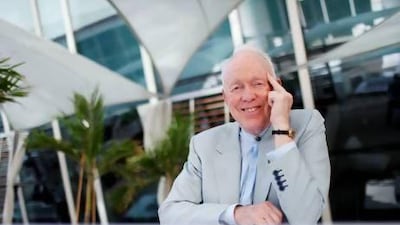He is known as "that brain guy", or as the father of mind mapping, but professor Tony Buzan prefers to view his work as exploratory rather than simply research.
Starting with his popular 1970s BBC series Use Your Head and now, with more than 100 books published, Buzan's message is that we can use our brains more effectively if we are prepared to be more creative.
Speaking at the Emirates Airline Festival of Literature over the weekend, Buzan reveals - with a fistful of coloured pencils - that he completed numerous mind maps during his latest travels.
"I keep them in my head, in my diary, in manuals," he says. "I have written something in a piece of paper in a restaurant."
The mind map begins with an image placed centre of the page, spawning numerous worded branches bearing fruit to further images relating to the one in the centre.
The branches, and in particular the central image, should be distinctly coloured and the drawings should be done loosely and off the cuff.
The result is a colourful affair that may seem like a children's drawing to a stranger yet feel strangely familiar to the creator. That intimacy is no mistake, Buzan says. That's your mind talking to you.
"It is a reflection and a mirror of the way the brain thinks," he says. "So when you do a mind map, your own brain looks at it and says: 'Wow, that's me. I'm pretty colourful.' When you allow the brain to speak its own language, you will it to communicate more eloquently and more fluidly."
The mind map's origins stem from Buzan's frustrations at traditional memory techniques. With his high school grades sliding, Buzan despaired at the "linear forms" of studying methods such as the to-do list and cheat cards and looked for more creative ways to remember and learn.
"I went to the library and said: 'I need a book on how to use my brain' and the librarian said: 'It's over there in the medical section.' I said: 'I don't want to operate on it. I want to l learn how to use my brain' and she said: 'There are no books on that'," he recalls. "So I began exploring the territory, experimenting with colours or no colours. Colours always worked. Images always worked. Keywords always won and that took years of experimentation."
Buzan explains that the effectiveness of mind maps lies in the brain's underestimated knack for understanding imagery.
"It is filled with images and one picture is worth a thousand words. The branches are not linear. They radiate because the brain is a radiant thinking tool," he says. "So if you got a mind map with 10 images, that is 10,000 words of information. It is a very poetic device."
While Buzan's method has been hailed as a new way of thinking, he views his work as another chapter to one of the oldest subjects of all.
"In most cultures many people didn't know where the brain was. Some people thought it was in the stomach, which was sensible. Some thought it was in the sky wandering somewhere. It was only in the very few recent years that people realised that the main central computer was in the head," he says.
"It was the great thinkers that came with fundamental observations. Aristotle, who devised scientific thinking, said the highest level of thinking is metaphor. [Leonardo] da Vinci said the same thing. So all the great thinkers came to the same conclusion: that the brain works on images, on multi-senses, on the ability to interconnect and to integrate the energy of its emotions to guide rather than being thrown off the stallion of passions."
As well as a new official biography to be released later in the year, Buzan will continue preaching the wonders of the mind by setting up a series of international "academic thinking centres". He says the is UAE definitely on the list.
"The UAE is a beacon, if you like, in developing the intelligence of their nation and that is the best resource that anyone's got," he says.
"Even better than oil and gold, the currency of intelligence is by far the most valuable."
For more details go to www.tonybuzan.com
Follow us


